Home > Vibration Training > Research on Vibration Training
Research on Vibration Training
Strength IncreaseResearch suggests Vibration Training can be an efficient alternative to conventional exercise programs to improve strength and increase fat free mass (Roelants et al 2003). In a study of untrained females over 24 weeks, one group undertook conventional cardiovascular and resistance training (Roelants et al 2003). The second group undertook vibration exercise. Both groups trained 3 times a week. The fitness group followed a standard cardiovascular and resistance-training program including dynamic leg press and leg extension exercises (20-8 RM). The vibration group performed unloaded static and dynamic exercises on a vibration platform. A significant strength gain was recorded in the vibration group (+24%) versus the fitness group (+ 16.5%).The duration of the vibration exercise programs was between 20-30 minutes (including rests) versus between 45-75 minutes for the fitness group. In a second study of sixty seven untrained females, isometric and dynamic knee-extensor strength increased by 16.6% and 9% in the vibration exercise group versus 14.4% and 7% in the group who trained on conventional resistance equipment (Delecluse et al 2003). |
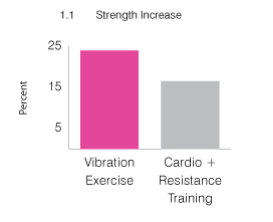
|
Bone Mass Density IncreaseStudies indicate that the high frequency of vibration exercise may have an osteogenic effect. In a study of healthy, postmenopausal women, a 24-week whole body vibration program was shown to improve muscle strength, balance and hip bone density (Verschueren, Roelants, Delecluse, Swinnen, Vanderschueren, Boonen, 2004). These are well-recognised factors for hip fractures. The Bone Mass Density (BMD) of the hip increased by 1% on average for the participants. No improvements in hip BMD were shown in a second group who undertook conventional resistance training (-.5%). This is also impressive when you consider that positive effects from high-impact exercises on BMD have not even been observed in studies after one year of conventional training. |
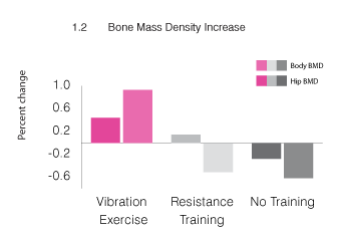
|
FrequencyResearch indicates that the highest muscle reflex response may occur between 30Hz and 40Hz. In a study conducted on sixteen professional women volleyball players, subjects were asked to squat on a vibration machine at different frequencies (Cardinale and Lim, 2003). The Electromyography Activity (EMG) of the largest part of the quadriceps muscle was measured for 60 seconds whilst the subjects were squatting on the platform. The results in the graph below indicate that vibrations generated a greater reflex response than no vibration. It also indicates that the peak response was between 30Hz and 40Hz. There was a statistically significant reduction in response at 50Hz suggesting a lower response at this frequency. Overall the study suggests peak muscle reflex response may occur between 30Hz and 40Hz with diminished response at 50Hz.Jump Height IncreaseSeveral studies have demonstrated that vibration exercise can lead to an increase in jump height. In a study of sixty seven untrained females, vertical Counter Movement Jump Height (CMJ) increased by 7.6% after 12 weeks of vibration exercise (Delecluse, Roelants, Verschueren, 2003) but did not increase in the resistance training group. CMJ is a measure of explosive strength, indicating that vibration exercise may be beneficial to athletes who require explosive strength in their sport. (Plyometric and jumping exercises have been used inthe past to improve this). Similarly, Torvinen (2002) found an 8.5% increase in jump height in a study of 55 volunteers (male and female) who engaged in vibration exercise for four months. Lower Back Pain ReductionVibration Exercise can relieve pain and improve pain-related limitation in everyday life for people with Chronic Lower Back Pain (Rittweger, Just, Kautzsch, Reeg, Felsenberg, 2002). It can also increase lumbar extension torque for people with this condition. These effects are similar to those experienced by sufferers who trained doing lumbar extensions.Figure 1.4: Pain sensation, assessed on a viusal analog scale ranging from 0 to 10, during the 12 exercise weeks with lumbar extension training and whole-body vibration exercises. Bars denote the standard deviation. In both groups, there was a significant reduction in pain sensation, with no significant difference between the groups |
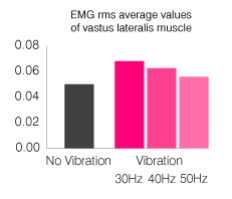 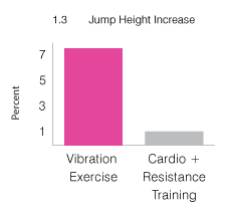
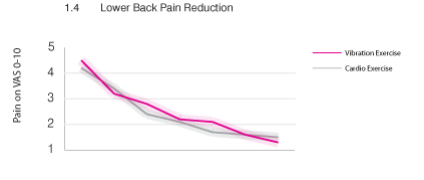
|
Perceived Exertion & Training TimeVibration Exercise elicits an involuntary contraction of the muscles, inducing strength gains in previously untrained users within a short period of time and without much effort (Delecluse et al 2003). There appears to be a preference for vibration exercise over weight training for obese people due to lower perceived exertion (Roelants, Delecluse, Goris, Veshueren, 2004). As most obese people are not really attracted to physical activity, Vibration Exercise may reduce the threshold to start an exercise program as it leads muscle activity that is partly reflexive and hence perceived exertion is lower. Training times are also substantially shorter than traditional resistance and cardio training programs. The duration of the Vibration Exercise program in a typical study, was between 20-30 minutes (including rests) versus between 45-75 minutes for the traditional cardio and resistance training group (Roelants et al 2004).
The cardio vascular effects of Vibration Exercise are mild. Blood pressure and heart rate rises are moderate and return to normal within 15 minutes of recovery (Rittweger, Beller, Felsenberg, 2000). As such, the risk when Vibration Exercise is used with the elderly is small. Muscle power and strength are important and independent predictors of functional performance and falls of older people (Torvinen, Kannus, Sievanen, Jarvinen, Pasanen, Kontulainen, Jarvinen, Jarvinen, Oja, Vuori, 2002). Strength training is what older bodies, even very old or frail ones, need to fight the loss of muscle mass and strength, according to the American College of Sports Medicine (ACSM). However strenuous load-bearing exercises can increase their risk of injury. Vibration Exercise may therefore be an efficient form of training for them, especially in combination with its effect on bone density.
|
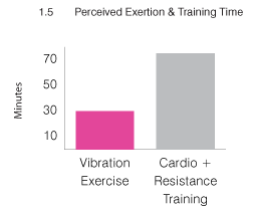
|
Cellulite AppearanceA German skin clinic conducted a trial to see what effect Vibration Exercise has on the appearance of Cellulite (Sanaderm 2003). Fifty-five female subjects trained for 24 weeks either using Vibration Exercise, Vibration Exercise plus Cardio Exercise or no exercise at all. Cellulite on each person was assessed at the start and end of the study on the basis of its appearance: Stage 1: Not normally visible cellulite unless the skin is pressed to the thighs; Stage 2: The cellulite is visible without pushing the skin on the thighs together whilststanding; Stage 3 The cellulite is visible without pushing the skin together while lying. The Vibration Exercise group experienced on average a 25.68% reduction in the appearance of cellulite. The Vibration + Cardio Exercise Group experienced on average a 32.3% reduction in the appearance of cellulite. The no exercise group experienced no improvement. Interestingly the total training time over 24 weeks for the Vibration Exercise group was only 11 hours versus 40 hours for the Vibration + Cardio Exercise group. Thus a 264% increase in training time only resulted in a 26% improvement in cellulite appearance. It should be noted that this study has not been replicated nor published in a scientific journal and as such has not been peer reviewed. There are several cellulite studies currently being conducted that should provide further support for these findings CirculationPower Doppler measurements of muscular blood circulation in the calf and thigh significantly increased after Vibration Exercise (Schindl, Grampp, Henk, Resch, Preisinger, Fialka-Moser, Imhof 2001). The results indicate that low-frequency vibration does not have the negative effects on peripheral circulation known from occupational high-frequency vibration.
Vibration Exercise has been shown to increase blood concentrations of Testosterone and Growth Hormone in men. Cortisol was shown to drop (Bosco, Iacovelli, Tsarpela, Cardinale, Bonifaze, Tihanyi, Viru, Lorenzo, Viru, 2000). |

|
Click Here For References and Other Information
